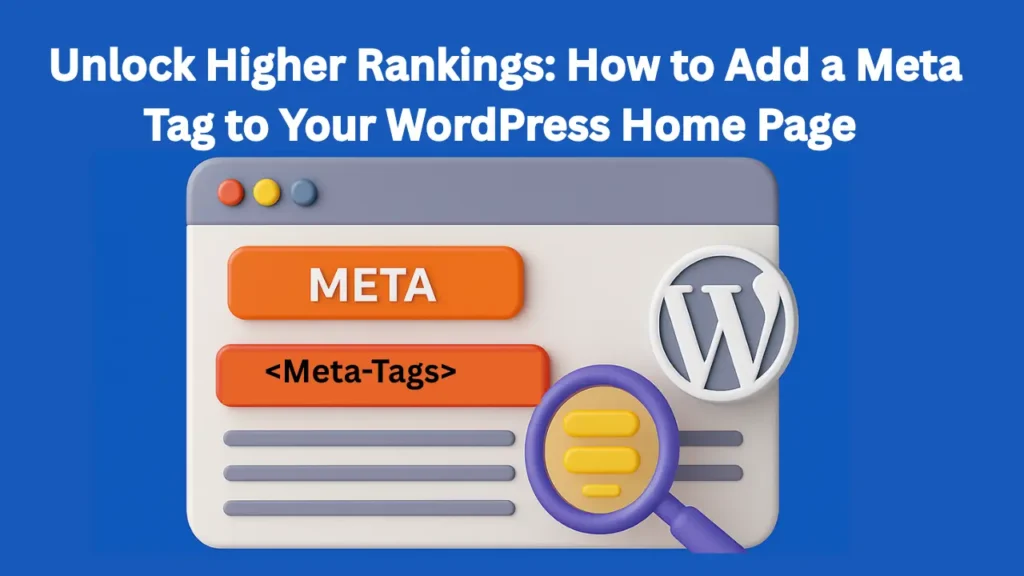If you’re looking for a way to improve your WordPress site’s SEO, one of the simplest and most effective actions you can take is learning how to add a meta tag to your WordPress home page. Whether you’re verifying ownership in Google Search Console, optimizing click-through rates, or improving metadata, meta tags play an essential role in helping search engines understand your site.
In this article, we’ll walk you through why meta tags matter, and show you step-by-step how to add them to your homepage, both with and without plugins.
Let’s get started.
What Are Meta Tags & Why Should You Care?
Meta tags are snippets of HTML code that provide metadata about your website. The most common ones include:
-
Meta Title – Appears as the page title in search results
-
Meta Description – A brief summary shown below the title
-
Meta Keywords – Once important, now mostly ignored by Google
-
Meta Verification Tags – Used to verify ownership in tools like Google Search Console or Bing Webmaster Tools
These tags don’t appear on the page itself, but they are extremely important for SEO and user experience. As per Google Search Central, well-written metadata can improve how your site appears in search results and increase click-through rates.
How to Add a Meta Tag to WordPress Home Page (With & Without Plugins)
There are two main ways to add meta tags to your homepage in WordPress:
Method 1: Using an SEO plugin
Method 2: Manually adding code via theme files
Method 1: Using an SEO Plugin (Recommended for Beginners)
If you’re not comfortable editing code, this is the safest and fastest way.
Step-by-Step Using Rank Math or Yoast SEO:
-
Install Rank Math or Yoast SEO from the WordPress Plugin Repository.
-
Go to your WordPress Dashboard → SEO Plugin Settings.
-
Under Search Appearance or Titles & Meta, locate Homepage Settings.
-
Add your meta title and description. You can also include verification meta tags here if needed.
-
Save changes.
These plugins also automatically add structured data and Open Graph tags for social media, making them a well-rounded solution for SEO.
Pro Tip from Wix Infotech: We recommend Rank Math because it’s lightweight, powerful, and offers more features for free than most paid tools.
Method 2: Manually Adding Meta Tags (No Plugin Required)
Want more control or prefer to keep your site plugin-free? You can manually add meta tags using WordPress theme files.
Here’s how:
-
Navigate to your WordPress Dashboard → Appearance → Theme File Editor
-
Open the
header.phpfile -
Find the
</head>tag, and insert your meta tag just before it:
<meta name=”description” content=”Your meta description goes here.”>
-
Save the file
-
Visit your homepage and inspect the page source (
Ctrl + U) to verify that the meta tag appears correctly.
Warning: Always use a child theme or take a backup before editing your theme files. Updates to your theme can overwrite manual changes.
Related Articles 👉
No Plugins, No Problem: How to Add Meta Keywords in WordPress Without Plugin
Struggling with SEO? how to add a meta tag to your site’s home page wordpress (The Right Way!)
Google AI Mode Rolled Out in India: A New Era of Smarter Search
Want help setting up or optimizing your WordPress
website’s SEO properly?
We do it all—from setup to strategy:
At Wix Infotech, we specialize in helping businesses build powerful online presences with smart, scalable solutions.
Trusted External Sources Used
Best Practices for Meta Tags in WordPress
Here are a few expert tips to get the most out of your homepage meta tag:
-
Keep meta descriptions under 160 characters
-
Use relevant keywords naturally
-
Write descriptions that encourage clicks (“Get started now,” “Explore solutions,” etc.)
-
Avoid duplicate meta tags across your site
-
Don’t forget to update your meta data as your content evolves
Adding meta tags might seem like a small task, but they form the foundation of good SEO practices.
Final Thoughts
Now that you know how to add a meta tag to your WordPress home page, you’re better equipped to optimize your site for both users and search engines. Whether you choose a plugin or go the manual route, what’s important is that your metadata reflects your content and encourages action.
Need a hand with setup or want experts to take care of it for you?
Contact our team at Wix Infotech and let’s make your website shine online—faster, smarter, and SEO-ready.

